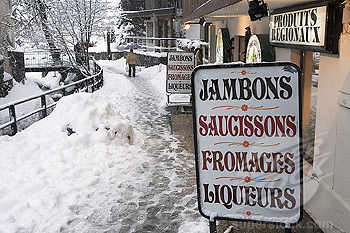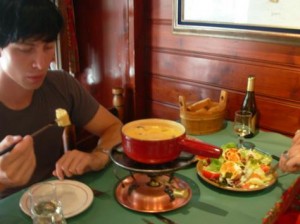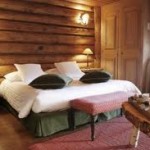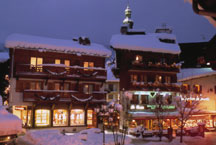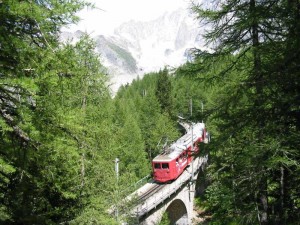Megeve Guide
Megève has some of the best mountain restaurants of any European resort. There are 34 to choose from, nearly all of which are table service and offer wonderful homely and nourishing Savoyard specialties in quaint log cabin settings.
Mont d’Arbois area
Les Mandarins (04 50 21 31 27) Location: Mont d’Arbois. The oldest mountain restaurant in France. Nice rustic atmosphere, good food and spectacular views. A fairly expensive option.
La Raviere* (04 50 93 15 71) Location: ski down to Communailles. This is a very small cabin restaurant with few tables inside or out. It is also one of the very best – so book ahead! They do not accept credit cards. Highly recommended.
L’Idéal* (04 50 21 31 26) Location: at the top of the princesse gondola. Rothschild-owned and serving delicious, authentic Savoie fare. Another highly recommended eaterie – book ahead or be disappointed.
Jaillet area
Auberge du Christomet (04 50 21 11 34) Location Jaillet: halfway down from the Cristomet Chairlift. A wonderful and welcoming gourmet favorite, this restaurant is also really great value, with a three course feast typically under €30.
Face Au Mont Blanc (04 50 21 06 51) Location: at the Jaillet cable car. Popular but pricey mountain restaurant, with buffet-style service.
La Babotch (04 50 91 93 96) Location: ski down green Rosiere. Very cozy and well-priced restaurant. Recommended.
Rochebrune area
L’Alpette* (04 50 21 03 69) Location: on the Rochebrune piste, five minutes by chairlift from the Rochebrune cable car. An expensive but wonderful gourmet treat, serving delicious charcuterie delights. It also has a sun terrace with some of the best views of Megève. This is the best of the mountain restaurants. Reservations essential.
La Radaz* (04 50 58 94 44) Location: on the piste above the Cote 2000. This traditional mountain hut has all you’d expect, including the rustic interior and great Savoyard specialties. One of the best.
Chalet Forestier (04 50 21 12 95). Location: on the Rochebrune piste, a two-minute ski from the Caboche cable car. Set in a picturesque locale covered in fir trees, this quiet restaurant serves large portions of authentic Savoyard food. Friendly service.
La Caboche (04 50 21 55 19) Location: top of Caboche cable car. Decent food and fast friendly service.
Auberge (04 50 21 31 84) Location: at the bottom of Cote 2000. The ambience and food here are among the best on the mountain. However, the staff have a very anti-Brit bias, and whether you speak good French or not, you will find yourself getting seated and served last. You have been warned!
There are nearly 100 restaurants to choose from in town so you’re spoilt for choice.
Best gourmet
Flocons de Sel (04 50 21 49 99) 75 Rue Saint-François. Michelin-starred Savoyard farmhouse, serving fantastic six-course meals. Head chef Emmanuel Renaut is renowned as one of the best in Megève.
Puck Owned by the same esteemed chef as Flocons de Sel. A pleasingly relaxed and moderately-priced paradise for gourmets. Recommended.
Most unique
Domaine de la Sasse (06 09 90 30 29) Cote 2000. Just outside Megève in Cote, and hidden from the main road (there’s a 20-minute walk once you leave the car); this is a private, almost unknown place. The patron, Dominique Meridol, lives in solitude on Mont Joly, and his specialty is bison served in every way possible. A unique experience you’ll be talking about for years.
La Tavern du Mont D’Amboise (04 50 21 03 53) 2811 route Edmond de Rothschild. Owned by the Rothschild’s, who run mountain restaurants L’Auberge de la Côte 2000 and L’Idéal, this is a fantastic welcoming place with a cozy open fire and friendly service. The specialty is grilled asparagus but all the meat dishes are also excellent. The cheese selection is considerable and the desserts among the the best in town.
Les Enfants Terribles (04 50 58 76 69) Main town square, next to the Mont Blanc Hotel. A little expensive but lots of choice and great quality.
Brasserie Centrale (04 50 21 22 44) Main town square. Serves great fondue as well as pizza and other dishes.
Phnom Penh (04 50 21 12 49) 1423 Route Nationale. Serves intriguing and tasty Asian-infused alpine cuisine.
APRES-SKI
Megève does not have a boisterous Austrian-style après-ski scene – this is more like going out on the town, albeit a very quaint and atmospheric one. There are countless places to eat out in style, and some really lovely swish bars with live music, plus ice hockey and a casino to cater to the mainly well-heeled clientele.
Best Bars
Calèche (04 50 58 99 13) Rue Monseigneur Conseil. Many head here straight after skiing. A really smart and stylish bar and a good place to start your night. Lots of live music.
Bar Tabac St Paul (04 50 58 25 79) Quai Prieure. A cozy little bar frequented by the locals; good for a less expensive beer or three.
Le Prieure (04 50 21 01 79) 116 Place de l’Eglise. Wonderful ambience in this petit tea room, restaurant and bar sitting right under the church tower on the square. Serves excellent fine food.
Le Chamois (04 50 21 25 01) 21 Rue Monseigneur Conseil. Another cozy little eaterie and bar right by the old church. Serves excellent fondues.
Club de Jazz des Cinq Rues* (04 50 91 90 69) Rue du Comte-de-Capre. Only open during the winter season. Attracts notable jazz greats. For live music, lots of drinks and a great atmosphere, look no further.
Wake Up (04 50 58 25 79) Route Edmond-de-Rothschild. Cosy and friendly little warm-up, warm-down bar with tapas snacks. For pre and post-clubbers – Le Pallas nightclub is conveniently on the same road.
Cocoon (04 50 21 09 91) Route Edmond-de-Rothschild, near Wake Up and club Les Caves. Small and cozy. There’s a dance floor if you fancy it, and they usually have live music. Open until dawn.
Best clubs
Palo Alto In the casino, just by the ice rink. The ground floor is a piano bar, with dancing upstairs in the club for a younger crowd. Open until 5am.
Le Pallas (04 50 91 82 70) Route Edmond-de-Rothschild. The less mainstream crowd heads to this underground cellar-bar, where you can relax in the lounge or hit the dance floor.
Les Caves de Megève (04 50 21 30 11) Rue Ambroise Martin. Long established and very popular smart club.
Cargo (04 50 58 78 70) Rue Ambroise Martin, near Les Caves. The oldest club in Megève, but has some great DJs that work the crowd until dawn.
HOTELS
Megève has some of the most luxurious hotels of any French ski resort, ranging from old and traditional in style to modern, Art Deco and avant-garde.
Best for luxury
Chalet du Mont d’Arbois 4* Rothschild-owned, this beautiful hotel treats guests like royalty. Traditional and opulent. Close to the Mont d’Arbois gondola.
Chalet St Georges 4* Situated right next to the Chamois cable car, this a really charming and cozy hotel with an excellent restaurant open for lunch and dinner.
Best for location
Hôtel Mont-Blanc 4* Central location close to all the action, so you won’t have any trouble walking to the best night spots and restaurants in town. Also close to the Chamois gondola.
Les Fermes de Marie 4* this phenomenon – a small (10-bed) chalet hotel built out of old farmhouses painstakingly taken apart and reassembled – provides luxurious accommodation with a difference. It’s located five minutes from the center but if you don’t want to head into town the hotel has everything you need – three gorgeous restaurants, a health spa, indoor swimming pool, beauty treatment center, a bar and even a library.
Best for travelers on a budget
Au Coeur de Megève 3* Family-run and very cozy. In the centre of town, ideally placed for nightlife and eating out.
Le Gai Soleil 2* A simple chalet-style hotel that is nicely located in the centre of town and close to the lifts. The staff are friendly and helpful, there’s a good bar, and the rooms are comfortable.
Hotel La Prairie 3* A quality chalet hotel with large rooms and traditional design. This is a good place to stay for the weekend, as you’re close to the centre of town.
GETTING THERE
Megève is less than 50 miles from Geneva airport, about a one-hour drive.
By Rail
Fast TGV trains travel from Geneva to Sallanches, about eight miles away. From there, there are regular bus services to Megève.
By Car
From Geneva, follow Route de Malagnou and take A411/E712 into France, passing Thonex and Annemasse. Then take the A40/E25 after about two miles, passing Bonneville and Scionzier, towards Exit 20 (signposted Albertville/Sallanches/Megève). Take the N205 towards the N212, which passes through Combloux before arriving at Megève. NB: Megève is car-free, so you will have to leave your vehicle in one of the designated car parks.


